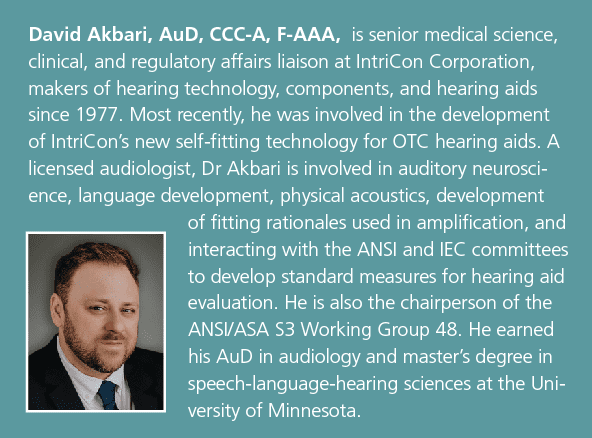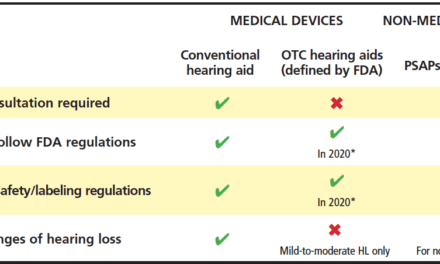Tech Topic | November 2022 Hearing Review
The future for hearing aids, those in the industry, and people with hearing loss has never looked brighter
By David Akbari AuD
Over-the-counter (OTC) hearing aids herald a new golden age for consumer access and affordability and will lead to improvements in technology innovation and public health outcomes in the coming years. This historic moment represents a rare opportunity to reimagine and improve on the service delivery model for audiologists’ offices that will likely lead to increased consumer satisfaction and additional opportunities for provider revenue.
Consumers and hearing healthcare providers alike are uniquely positioned to benefit from the finalized OTC rule. OTC hearing aids will provide much-needed relief to tens of millions of un- and under-served Americans suffering from perceived mild-to-moderate hearing loss currently with limited and more expensive options to treat their perceived hearing issues. Skilled, licensed audiologists will also benefit, as they now become expert providers of critical, domain-specific knowledge associated with the use and management of OTC hearing aids for the treatment of perceived mild-to-moderate hearing loss. They will also continue to provide the high-touch, hands-on service to people who prefer and need it, primarily those with more severe hearing loss.
OTC hearing aids have been a long time in the making. In 2016, the United States spent nearly twice as much on overall health care as other high-income countries, yet had poorer population health outcomes. In 2015 and 2016, then-President Obama commissioned research by the President’s Council of Advisors on Science and Technology (PCAST) and the National Academies of Science, Engineering, and Medicine (NASEM). Among their findings were that even if every single audiologist and hearing instrument dispenser were fitting people full time with hearing aids, every day, there would still be a huge and growing unmet need in the United States for hearing healthcare. This startling statistic helped form the foundation for the new OTC hearing aid category.
Along with the FDA’s promulgation of the final OTC rule, is the parallel and simultaneous effect OTC legislation will have on prescription hearing aids. Along with specifying the details that OTC hearing aids must comply with, the FDA has further reclassified all non-OTC hearing aids as prescription hearing aids. The reason for this is the removal and repeal of federal statutes that previously preempted state and local laws, which results in previously unenforceable laws now being enforced again. This is most notable around the requirement of a medical waiver prior to receiving hearing aids, which the FDA has declined to enforce since 2016. The finalized OTC rule removes the federal preemption of several state and local laws that had been previously preempted. In light of this change, one of the best resources audiologists have access to is their state professional organization. I would urge all readers of this article to join and advocate for the profession at the state level. I would also encourage you to carefully evaluate which national professional organizations are serving your needs and are likely to produce continuing value to you in a post-OTC landscape.
For many years, traditional hearing aid industry manufacturer incumbents have leveraged their considerable power and influence over the broader market through consolidation and incremental innovation in research and development, arguably with marginal impact to the consumer experience. In many cases, this consolidation effort involves large manufacturers buying up small groups of private-practice hearing healthcare providers whose practices are then fully owned by the larger parent organization – the manufacturer. While this can help streamline distribution channels for hearing aid products and ensure process consistency among providers, this can also serve as a barrier to entry for many consumers and leaves the industry in a spot of stagnant innovation that is ripe for disruption. Regulations involving the dispensing of hearing aids effectively became what economists call a barrier to entry, as it reduces the ability for consumers to effectively comparison shop, thereby reducing competitive pressure on pricing. If there is no incentive for companies to create a better product for a better price, inevitably there will be high costs and reduced health outcomes.
Also, many insurance plans still do not cover hearing aids, forcing consumers to cover the costs entirely out-of-pocket. This can represent additional strain on the already stretched budgets of US senior citizens and others on a fixed income. OTC hearing aids can provide additional opportunities for audiologists, especially hearing healthcare providers, because they require consumers to self-identify and self-manage their condition. When a larger range of people have access to safe and effective OTC hearing aid technology, it will encourage people to learn more about hearing loss, and therefore improve the health literacy of the public. The downstream effect of this is an increase in the perceived value of the audiologist, with less emphasis on the sale of hearing aids, and more focus on the valuable services of a skilled, licensed professional. Audiologists should celebrate this shift in perception, away from the focus on the sale and dispensing of the device, to the true value that can be provided by a trained doctor. The creation of the OTC category of hearing aids provides an effective and straightforward on-ramp for consumers to comparison shop, explore their options, and take ownership of the management of their condition, which for many will include hearing healthcare providers as key partners in the overall journey to better health and well-being.
Along with the improved access to hearing aids that consumers will have in a post-OTC landscape, there is also an opportunity to focus on the holistic hearing healthcare journey, where consumers do not simply stop at effective use of OTC hearing aids and continue into the prescription class of hearing aids. Prescription hearing aids will be a logical next step for many experienced OTC hearing aids users. When using a hearing aid as a medical device to accommodate for the reduced dynamic range in the impaired ear, loudness growth management is critical. OTC hearing aids will allow many people to get their first experience with improved hearing sooner and learn what works for them when and if they transition to prescription hearing aids.
The technology innovations spurred by a larger hearing aid consumer market, brought on by the OTC legislation, will also likely continue to increase awareness of the advantages of hearing aids. More people will discover the advantages of living a better life through the use of hearing aids. When this happens, it will highlight the role of the provider who is committed to evidence-based best practices for lifelong hearing loss treatment. While many newcomers to the industry will train customer service professionals to address the needs of the users of OTC hearing aids, skilled and licensed providers are best positioned to capitalize on the circumstances around OTC hearing aids and will remain as key allies and advocates for those individuals seeking treatment that goes beyond OTC hearing aids.
Consumers will also directly benefit from learning more about which products are right for their needs, while also learning more about their unique hearing needs and where they need the most help. This will encourage new entrants into this newly forming market segment which will likely result in key product innovation like new methods of self-fitting and self-selection of preferred audio settings, much like an advancedtone control on your home stereo system, that may also address the chronic problems reported by consumers, such as hearing in the presence of background noise.
Opponents of the now finalized OTC rule suggest that the care of the hearing professional is essential for best patient outcomes. Many agree with this sentiment. That said, many people in the US with mild-to-moderate hearing loss would be thrilled to settle for any positive outcome, regardless of how it was obtained. And many of those people simply cannot or will not pay the higher cost of hearing aids that are provided through a visit to the audiologist. Consumers now have the option to choose, including the choice to pick OTC hearing aids over nothing at all.
The consequences of untreated hearing loss include earlier and more severe onset of dementia and other diseases that can result in progressive cognitive decline. Giving the control and power back to the consumer to identify and manage their conditions allows audiologists and other hearing healthcare providers to function as key allies and advocates for the aspects of audiology that can have a lasting impact on people’s lives, beyond just the prescription and sale of a device. This will also elevate the least privileged among us to be able to access affordable care in a way that does not compromise safety and satisfaction, thanks to the robust special controls the FDA is requiring in the final OTC rule. People come in all different shapes, sizes, colors, and preferences. The landmark OTC hearing aid final rule will allow consumers the ability to select products that meet them where they are and match their needs best in a way only the consumer themselves can decide.
In my opinion, in the next five years hearing healthcare will see more innovation and consumer choice than have been available in the previous 50 years. Allowing consumers to choose the product that is right for them, and to take ownership of their health condition, will improve health literacy and reduce health disparities in outcomes among all Americans. It is on this basis that a new golden age of hearing healthcare can emerge and flourish, with new levels of consumer choice and technological innovation. The future for hearing aids, those in the industry, and people with hearing loss has never looked brighter.

Citation for this article: Akbari D. Why OTC hearing aids will help many people, including audiologists. Hearing Review. 2022;29(1):26-28.



.gif)

